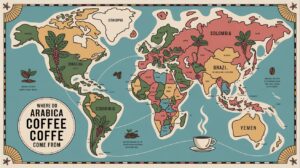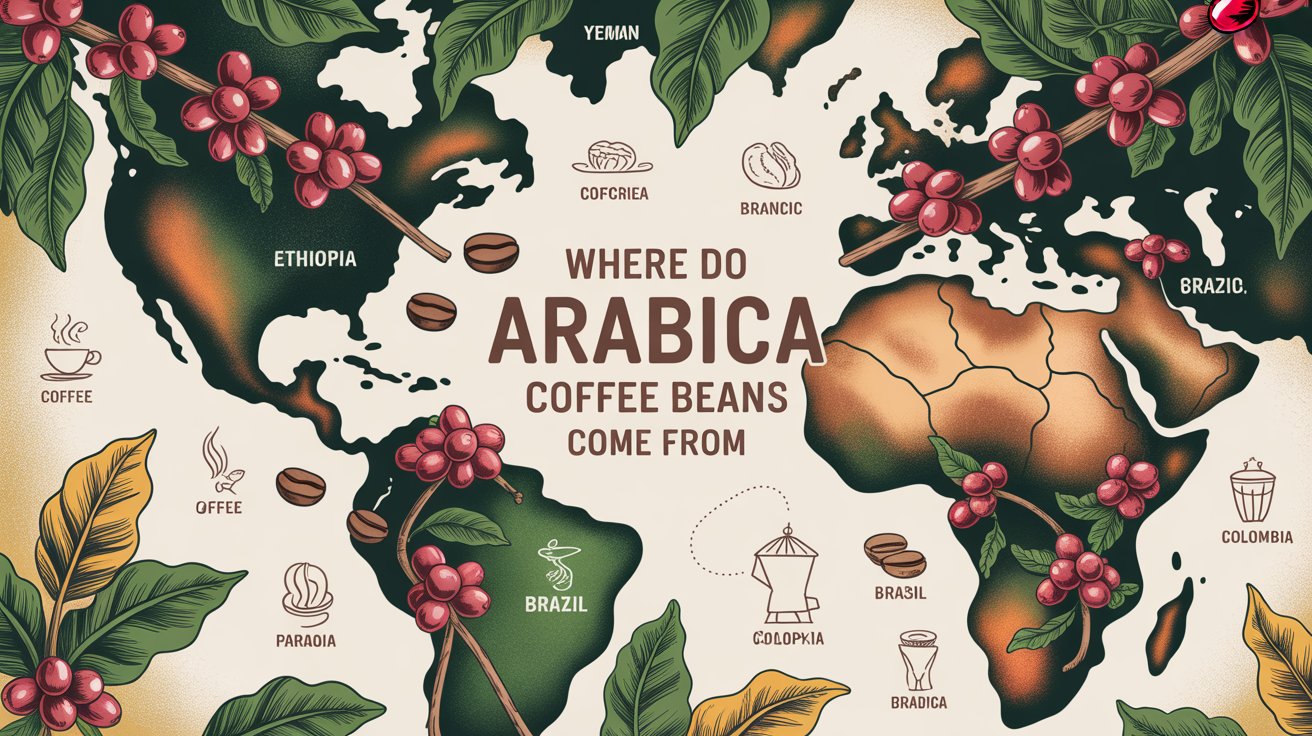Where do Arabica coffee beans come from? Most coffee lovers sip their morning brew without realizing they’re tasting history.
Arabica coffee beans come from the Coffea arabica plant, native to Ethiopia’s lush, high-altitude forests—where it still grows wild today.
Legend says a goat herder discovered its energizing effects centuries ago. From there, Arabica traveled across the Red Sea to Yemen, where it was first cultivated and traded with the world.
What started in ancient Ethiopia became a global obsession—fueling cafés in Europe, plantations in Latin America, and specialty brews everywhere in between.
But not all Arabica beans are created equal. Their origin dramatically shapes their flavor, aroma, and quality.
If you’ve ever wondered why Ethiopian coffee tastes floral while Colombian beans feel nutty and smooth—this story explains why.
Let’s trace the incredible journey of Arabica—from wild forest shrub to your cup.
Origins & Early History of Arabica Coffee
Arabica coffee didn’t just appear out of nowhere.
It evolved deep within the montane forests of southwestern Ethiopia, particularly the Kaffa region, which some say gave coffee its name.
Here’s what makes it fascinating:
Coffea arabica is a naturally occurring hybrid of two wild species: Coffea canephora (Robusta) and Coffea eugenioides.
It’s a genetically rich plant, still growing wild in Ethiopia, with thousands of naturally adapted varieties.
The Kingdom of Kefa was among the earliest regions to recognize and use the plant for its energizing effects.
Why it matters: Ethiopia’s wild Arabica is the genetic lifeline of the world’s coffee supply. Its diversity helps fight disease, pests, and climate change.
Legend of Kaldi and Early Ethiopian Use
The history of Arabica isn’t just scientific—it’s also steeped in legend.
According to Ethiopian folklore:
A goatherd named Kaldi noticed his goats dancing after eating red berries from a shrub.
Curious, he tried the berries himself and felt energized.
Monks later boiled the beans to stay awake during long prayers—giving rise to the first use of coffee as a beverage.
Whether true or not, the story of Kaldi captures how Arabica’s potential was first unlocked in Ethiopia.
User benefit: This origin story adds cultural richness to your coffee knowledge—and shows why Ethiopia is often considered coffee’s true homeland.
Transfer to Yemen and Arabian Cultivation
Arabica’s next chapter? A massive leap across the sea.
By the 7th century, Arab traders had transported Arabica plants from Ethiopia to Yemen, where the bean took root—literally.
Here’s what happened:
The Yemenis cultivated Arabica on terraced mountain farms, refining drying and roasting techniques.
The port city of Mocha became a global trade hub, exporting roasted beans to the Ottoman Empire, Europe, and beyond.
Because of this expansion, the plant was named “Coffea arabica”—even though its roots were Ethiopian.
Why this matters: Yemen was the launchpad for coffee’s global spread—turning Arabica from a local crop into a worldwide phenomenon.
The Global Spread & Cultivation Timeline
The Dutch saw opportunity in every bean.
In the late 1600s, the Dutch East India Company smuggled Arabica seedlings from Yemen and planted them in India’s Malabar Coast.
From there:
They expanded production to Java, Sumatra, and Ceylon, setting up coffee plantations across Southeast Asia.
Java coffee became famous—so much so that “a cup of Java” became slang for coffee itself.
Impact: These moves helped position Asia as a key Arabica growing region, still vital to today’s global supply.
Arrival in the Caribbean & Americas
The French took Arabica westward.
In the 18th century, they introduced Arabica plants to Martinique, from which it spread to:
Jamaica (giving rise to Blue Mountain coffee)
Cuba and French Guiana
Colombia, Central America, and eventually Brazil
This era birthed the Typica and Bourbon varietals—two foundational strains that shaped modern coffee cultivation.
Today’s takeaway: Countries like Brazil, Colombia, and Guatemala are now global leaders in Arabica production—thanks to centuries of planting, adaptation, and migration.
Major Modern Arabica-Producing Regions

Arabica coffee is grown in the Bean Belt—a stretch around the equator with the perfect combo of climate, altitude, and soil.
Let’s break down the top producing regions and what makes each unique.
Central & South America (Brazil, Colombia, Guatemala, Costa Rica, Honduras)
This region leads the world in Arabica exports. Here’s why:
Brazil: Largest producer. Grows beans at 2,000–4,000 ft. Known for nutty, low-acid, chocolatey profiles.
Colombia: Mountains range from 3,300–6,600 ft. Beans are balanced, fruity, and bright—ideal for specialty brews.
Guatemala & Honduras: Volcanic soils and microclimates deliver spice, cocoa, and citrus notes.
Costa Rica: Known for washed Arabicas grown above 4,000 ft, offering clean, crisp flavors.
User tip: If you want smooth and familiar, go with Colombian or Brazilian. For more punch, try Guatemalan or Costa Rican.
East Africa (Ethiopia, Kenya, Tanzania, Rwanda)
This is where Arabica was born—and flavor still rules here.
Ethiopia: Home to wild Arabica genetics. Regions like Yirgacheffe, Sidama, Harar, and Kaffa produce floral, citrusy, and wine-like beans.
Kenya: Grown at high altitudes (~6,000 ft). Expect juicy acidity, blackcurrant, and berry flavors.
Tanzania: Produces full-bodied beans with mild acidity and tropical fruit tones.
Rwanda: Small farms with high elevations create clean, tea-like coffees with floral aromatics.
Why it matters: East African coffees offer the most complex flavor profiles—ideal for third-wave enthusiasts and single-origin lovers.
Asia & Southeast Asia (Indonesia, India, Philippines)
This region’s Arabica beans are distinct—thanks to climate and processing style.
Indonesia (Sumatra, Java): Uses the unique “Giling Basah” (wet-hulling) process, producing earthy, full-bodied, low-acid coffees.
India: Grows shade-grown Arabica in Malabar and Bababudangiri Hills. Monsooned Malabar is woody, spicy, mellow.
Philippines: Regions like Benguet produce mild, sweet, and nutty Arabica at elevations over 4,000 ft.
Pro insight: Southeast Asian Arabica is ideal for espresso lovers who prefer low acidity and bold flavors.
Read Also:
👉 Geisha Green Coffee Beans
👉 Green Coffee Beans by Region Map
Optimal Growing Conditions & Plant Characteristics
Arabica isn’t easy to grow—but when conditions are right, it thrives.
Altitude, Rainfall & Temperature Range
Arabica prefers the high life. Literally.
Ideal altitude: 1,500–2,200 meters (4,900–7,200 ft)
Temperature: 60–73°F (15–23°C)
Rainfall: Between 40–80 inches annually
Soil: Well-draining, rich in organic matter
Shade & elevation slow growth and boost bean density, leading to more complex flavors.
Takeaway: The higher the altitude, the slower the bean matures—and the better it tastes.
Agricultural Profile of Coffea arabica
Arabica is genetically delicate—but that’s what makes it special.
It’s an allotetraploid species (from C. canephora × C. eugenioides).
Has twice the chromosomes of other species, which boosts flavor complexity.
Susceptible to pests, disease, and climate stress, especially coffee leaf rust.
Grown mostly in narrow climate zones, making it vulnerable but high value.
Why it matters: Arabica’s fragility makes it harder to grow—but it’s also the reason for its superior flavor and global demand.
Varietals & Flavor Profiles by Region
Not all Arabica beans are created equal.
Where they grow—and which varietal they belong to—shapes everything from aroma to acidity.
Let’s explore how flavor changes across regions.
Ethiopian Heritage Beans (Longberry, Shortberry, Mocha Harar)
Ethiopia isn’t just the origin of Arabica—it’s a flavor powerhouse.
Longberry: Large beans, bright acidity, and strong floral and citrus notes
Shortberry: Slightly smaller, with more spice and body
Mocha Harar: Known for winey, bold, and fruity complexity—a favorite in specialty markets
Why it matters: These heirloom beans grow in wild or semi-wild conditions, making each micro-lot unique.
Latin American Varietals (Typica, Bourbon, Caturra, Catuai)
These varietals dominate farms across Colombia, Guatemala, Brazil, and Costa Rica.
Typica: The original strain—clean, balanced, and delicate
Bourbon: Sweeter, more complex with chocolate undertones
Caturra & Catuai: Shorter plants, more productive, often nutty, smooth, with mild acidity
Pro tip: If you enjoy balanced, crowd-pleasing brews, Latin American beans are your go-to.
Indonesian & Southeast Asian Styles
These beans deliver boldness and body—thanks to environment and processing.
Sumatra, Java, Sulawesi: Use Giling Basah (wet-hulling), which strips parchment early
The result? Earthy, full-bodied, low-acid coffees with flavors like tobacco, cedar, and spice
Philippines (Benguet, Sagada): Milder but with distinct nutty and herbal notes
User insight: Southeast Asian Arabicas are perfect for drinkers who prefer smooth, rich, and less acidic cups—especially in espresso.
Challenges & Sustainability Concerns
Arabica’s future is under pressure—from both nature and policy.
Impact of Climate Change on Arabica Cultivation
Arabica is climate-sensitive—and the heat is on.
Ideal temperature range: 60–73°F
Even a 1.5°C rise can shrink viable growing land by up to 50% by 2050
Drought, pests, and irregular rainfall are already affecting crops in Ethiopia, Colombia, and Brazil
Why you should care: Less suitable land = lower yields = higher coffee prices and potential quality loss.
Trade, Regulation & Smallholder Pressure
Small farmers—who grow 80% of the world’s Arabica—face growing challenges.
The EU’s deforestation regulations threaten to block Ethiopian exports that lack digital traceability
Brazil faces tariffs from new international trade policies, driving up costs
Smallholder farmers lack infrastructure to adapt quickly, risking lost income and supply gaps
User insight: Behind every cup, there’s a farmer balancing cost, compliance, and climate.
conclusion
Arabica coffee beans come from Ethiopia’s ancient highlands, where wild plants first took root in misty mountain forests.
From there, they crossed the Red Sea into Yemen, cultivated and traded by Arabian merchants — giving rise to the term “Arabica.”
Today, Arabica thrives in high-altitude farms across Latin America, East Africa, and Southeast Asia, each region offering unique flavor profiles shaped by altitude, soil, and tradition.
But it all started with a single plant, a curious goat herder, and the world’s growing love for better coffee.
Understanding where Arabica comes from helps you make smarter, more meaningful brew choices — whether you’re chasing fruity Ethiopian notes or chocolatey Colombian smoothness.
FAQs About Arabica Origins & Beans
Where does Arabica coffee originally come from?
Arabica coffee originated in the highlands of southwestern Ethiopia, where it still grows wild today.
Why is it called “Arabica” if it began in Ethiopia?
Although native to Ethiopia, Arab traders first commercialized and cultivated the bean in Yemen, giving rise to the name Coffea arabica.
How does altitude affect bean flavor?
Higher altitudes = slower bean development, which leads to denser beans with more complex, vibrant flavors.
Which countries produce the most Arabica?
The top producers include Brazil, Colombia, Ethiopia, Honduras, and Guatemala—each offering distinct regional flavor profiles.

Mahian has an insatiable curiosity for discovering unique coffee beans and exploring global café trends. He delves into the stories of coffee origins, packaging innovations, and the evolving landscape of café culture. Mahian’s contributions provide readers with a broader perspective on the world of coffee.

